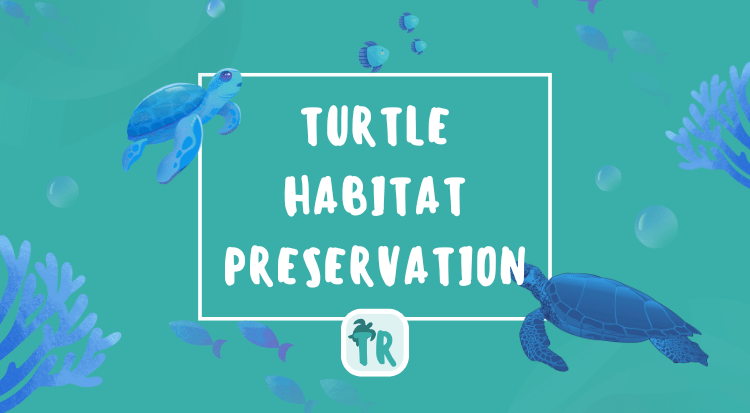Turtle Habitat Preservation - Quick Overview
Learn the importance of habitat preservation for turtles and how you can help protect and restore their natural homes to ensure their survival.

Preserving habitats is not only important but urgent for turtles' survival. Their homes provide food, shelter, and places to breed. Unfortunately, many turtle habitats are being destroyed or damaged by human activities.
This guide will explore the importance of habitat preservation, the threats turtles face, and what we can do to protect these vital environments. By understanding and acting to preserve habitats, we help ensure that turtles can thrive for generations to come.
Why Habitat Preservation Matters
Habitats are the natural environments where turtles live, feed, and reproduce.
Essential for Survival
- Food Sources: Habitats provide the plants and animals turtles eat.
- Breeding Grounds: Safe places for turtles to lay eggs and for hatchlings to grow.
- Shelter: Protection from predators and harsh weather.
Biodiversity Support
- Ecosystem Health: Turtles play a role in maintaining healthy ecosystems.
- Species Interactions: They interact with other plants and animals, creating a balanced environment.
Threats to Turtle Habitats
Many factors are damaging or destroying turtle habitats, leading to a significant decline in turtle populations.
Urban Development
- Construction: Building homes, roads, and businesses can destroy habitats.
- Habitat Fragmentation: Breaking up habitats into smaller pieces makes it hard for turtles to find food and mates.
Pollution
- Water Pollution: Chemicals and waste contaminate rivers, lakes, and oceans.
- Plastic Waste: Turtles can ingest or become entangled in plastic debris.
Climate Change
- Rising Temperatures: Affect nesting sites and can alter habitats.
- Sea Level Rise: Floods, coastal habitats, and nesting beaches.
- Extreme Weather: Storms can damage habitats and nesting areas.
Agriculture
- Deforestation: Clearing land for farming removes forest habitats.
- Pesticides: Chemicals can poison turtles and their food sources.
Illegal Activities
- Mining and Logging: Unauthorized extraction of resources destroys habitats.
- Poaching: Illegal hunting can disturb habitats and reduce turtle populations.
Strategies for Habitat Preservation
There are many ways to protect and restore turtle habitats.
Protected Areas
- Nature Reserves: Designated lands where wildlife is protected.
- Marine Protected Areas (MPAs): Sections of oceans safeguarded from harmful activities.
- Wildlife Sanctuaries: Safe havens specifically for endangered species.
Habitat Restoration
- Reforestation: Planting trees to restore forest habitats.
- Wetland Restoration: Rebuilding wetlands to support aquatic turtles.
- Beach Nourishment: Adding sand to eroded beaches to protect nesting sites.
Sustainable Practices
- Responsible Development: Planning construction to minimize habitat impact.
- Eco-Friendly Agriculture: Using methods that reduce harm to the environment.
- Pollution Control: Proper waste disposal and reducing chemical use.
Community Involvement
- Local Stewardship: Communities taking responsibility for nearby habitats.
- Education Programs: Teaching people about the importance of habitats.
- Volunteer Opportunities: Involving the public in conservation efforts.
How You Can Help Preserve Habitats
Every individual can make a significant difference in habitat preservation. By reducing, reusing, and recycling, supporting conservation efforts, practicing sustainable living, and respecting natural areas, we can all contribute to the survival of turtles and many other species.
Reduce, Reuse, Recycle
- Minimize Waste: Less trash means less pollution in habitats.
- Recycle Materials: Keeps waste out of landfills and natural areas.
Support Conservation Efforts
- Donate to Organizations: Financial support helps fund preservation projects.
- Volunteer: Participate in habitat cleanups or restoration projects.
- Advocate: Speak up for policies that protect habitats.
Practice Sustainable Living
- Use Less Water: Conserves freshwater habitats.
- Choose Sustainable Products: Avoid items that harm the environment.
- Reduce Energy Use: Helps combat climate change.
Respect Natural Areas
- Stay on Trails: Prevents damage to sensitive habitats.
- Do Not Disturb Wildlife: Observing from a distance keeps habitats undisturbed.
- Leave No Trace: Pack out what you pack in when visiting natural areas.
Success Stories in Habitat Preservation
There have been many successful efforts to preserve turtle habitats, such as the conservation of sea turtle nesting beaches in Florida and the restoration of wetlands in the Mississippi River Delta.
Sea Turtle Nesting Beaches
- Protected Beaches: Restrictions on development have saved nesting sites.
- Beach Patrols: Volunteers monitor and protect nests from predators and human interference.
Wetland Conservation
- Ramsar Convention: An international treaty that has protected many wetlands.
- Local Initiatives: Communities restoring wetlands to support local turtle species.
Reforestation Projects
- Mangrove Restoration: Planting mangroves that provide habitat for turtles.
- Forest Corridors: Connecting fragmented habitats to allow turtle movement.
The Role of Governments and Organizations
Governments and organizations play a crucial role in habitat preservation.
Legislation
- Environmental Laws: Regulations that protect habitats from destruction.
- Land Use Planning: Policies that consider environmental impact.
Conservation Organizations
- World Wildlife Fund (WWF): Works globally to protect habitats.
- The Nature Conservancy: Focuses on conserving lands and waters.
- Local Groups: Community organizations dedicated to preserving local habitats.
International Agreements
- Convention on Biological Diversity: An agreement to conserve biological diversity.
- Ramsar Convention: Protects important wetlands around the world.
Conclusion
Habitat preservation is essential for the survival of turtles. Protecting and restoring the places where turtles live ensures they have the resources they need to thrive.
Everyone can contribute to these efforts through personal actions, supporting organizations, or advocating for policies that protect habitats. Together, we can make a significant difference in preserving the natural homes of turtles and many other species.
